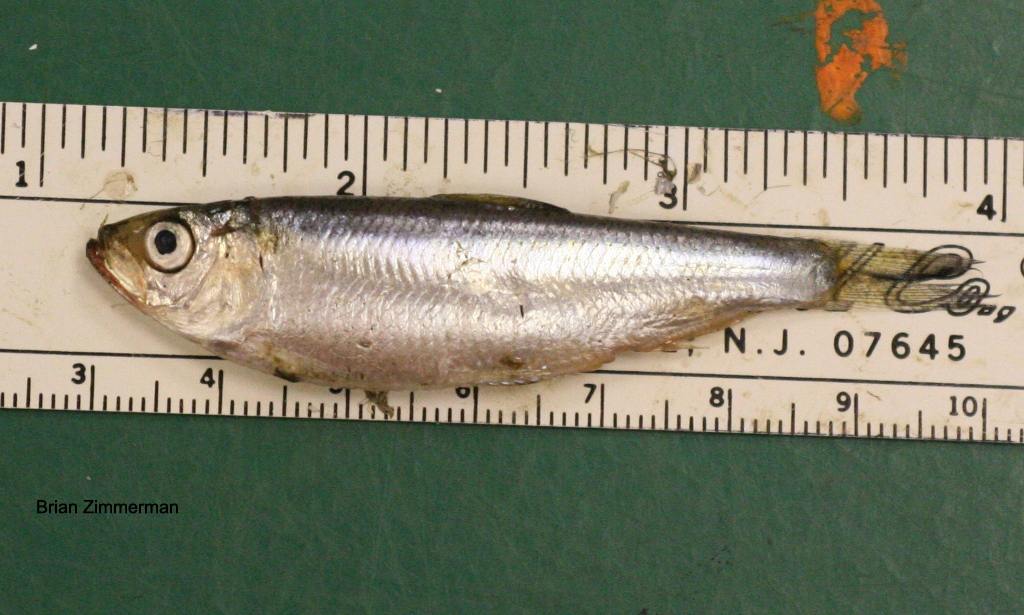The fate of both popular, but non-native, Lake Ontario sport fish and native species depends on alewives.

Alewives sustain popular sport fish, but can hurt populations of native lake trout and Atlantic salmon. Photo: dnr.state.md.us
But swings in the population of this invasive fish that other species like to eat forces a constant fish-stocking balancing act. Two years ago, it seemed the small prey fish was heading for a crash because of too many predators. But officials in New York and Ontario released a report this month that says alewife populations are stable and managers will continue stocking the fish that eat them at the same levels they have been.
Alewives are the primary food for popular and lucrative, but non-native, sport fish – chinook and coho salmon. They eat invasive zooplankton, like fishhook flea and spiny water flea.
But the news isn’t all good. They also eat native zooplankton that sustains native fish. They compete with perch for food. They eat young lake trout. Their guts have bacteria that cause a vitamin B1 deficiency in some fish that eat them. That can hurt reproduction in lake trout and sometimes kill Atlantic salmon — both native species.
For those managing Lake Ontario fish, the little prey fish are a dilemma.
“Alewife are an incredibly important baitfish for a very lucrative sport fishery that contributes about $144 million a year to the New York state economy,” said Steve LaPan, a Lake Ontario unit leader for the state’s Department of Environmental Conservation.
“But too many alewife hinder the restoration of other species,” LaPan said.
Echo reported in 2010 that Lake Ontario seemed destined for an alewife population crash because of growing chinook salmon populations.
That didn’t happen.
“The population is actually up a little bit from last year,” LaPan said. “We expect the adult population to go up this year too.”
A dearth of alewife would also spur poor growth in chinook salmon, which has not been the case, LaPan said.
The invasive small fish has crashed in Lake Michigan and Lake Huron. That resulted in the populations of fish that rely on them dropping while the numbers of fish with more diverse diets increased. Michigan officials just announced that they would cut their Lake Huron chinook salmon stocking in half this year, mostly because of the alewife crash.
And just because alewife appear strong now in Lake Ontario doesn’t mean that can’t change, LaPan said.
“As we know from (lakes) Michigan and Huron, Great Lakes ecosystems can change rapidly from exotic species,” LaPan said. “They can go off a cliff without much warning.”
With seemingly stable alewife populations, LaPan said officials would maintain the same salmon and trout stocking levels.
And it seems to be working for those who fish for a living.
“Catch rates have been very good the past few years,” said Bob Songin, captain of Reel Excitement Charters based Rochester, N.Y. Songin takes people on Lake Ontario to fish for chinook salmon and brown trout mostly.

Chinook salmon are popular among commercial anglers. They also eat a lot of alewives. Photo: duke.edu
Songin said there would always be people trying to restore the natural fish species like Atlantic salmon and lake trout. He recognized alewife can hurt these species through the vitamin B1 deficiency, but he hasn’t seen it.
“The survival of Atlantic salmon lately has been great,” Songing said. “We’re catching more Atlantics than ever.”
New York officials and charter captains like Songin give volunteers from charter associations young salmon and steelhead to raise in Lake Ontario tributaries. The fish are out of the hatchery sooner and charter captains know the fish will return to those tributaries in the fall to spawn, which helps them catch more.
This clears room for hatcheries to focus on Atlantic salmon and lake trout — native species that officials are trying to restore, while still keeping chinook and coho anglers happy.
“When you increase stocking of a species, that inevitably means something else will be decreased,” LaPan said.
There are groups unhappy with non-native stocking practices. But even those in favor of a native focus understand the ever-changing ecosystem.
“We would love to see restored natural ecosystems,” said Krystyn Tully, vice president of Lake Ontario Waterkeeper, an environmental nonprofit group that advocates for the protection of the lake.
“But we understand the only way to achieve healthy ecosystems is to have people feel a connection to the water and its well-being,” Tully said. “And a lot of times that means people sportfishing for stocked fish.”
LaPan agrees and said the notion of returning Lake Ontario to its natural state is a credulous one.
“There’s an ecological truth left out of this discussion — this isn’t the same lake as it was back then … whenever back then was,” LaPan said. “Even if we stopped stocking the big predators, we still have over 175 invasive species now.
“The lake is highly perturbed and will be for many decades.”
